VfB Stuttgart finished their campaign in the 2. Bundesliga in good fashion securing the 2nd place and earning promotion to the Bundesliga where they will play next season. Like any promoted team, Stuttgart are surely looking to add value to their squad with new players in order to face the new and bigger challenge of competing in Germany’s top division. Although new signings are very important for any promoted club, keeping their best performers in the squad is also crucial in order to really create a competitive squad.
Nicolás González was one of VfB Stuttgart’s top players in the 2019/202 season, the 22-year-old Argentine forward was the team’s top scorer with 14 goals while also contributing with three assists. Still at a relatively young age, González faces his first challenge in a top 5 European League and has everything to be successful and fall under the radar of bigger clubs in the future.
In this scout report, we will take a look at Nicolas Gonzalez’s style of play and performances for VfB Stuttgart in the 2. Bundesliga, a tactical analysis of in-game actions will allow us to identify his most common actions in the different phases of the game as well as some strengths and weaknesses. We will also take a look at the Argentine’s statistical profile in order to evaluate his output in key metrics as well as make a comparison with players from the 2. Bundesliga and the Bundesliga that play in the same position. This comparison will also allow us to make an estimate of what González’s output can be in the Bundesliga this next season.
Player Profile
Nicolás González is a 22-year-old winger that can also play as a centre-forward/second striker. In the 2019/2020 season, he mostly played as a centre-forward/second striker and left winger for VfB Stuttgart.
In the image below we can see González’s heat map for this season, it highlights the areas of the pitch where he has the most actions and, therefore, where he operates the most.
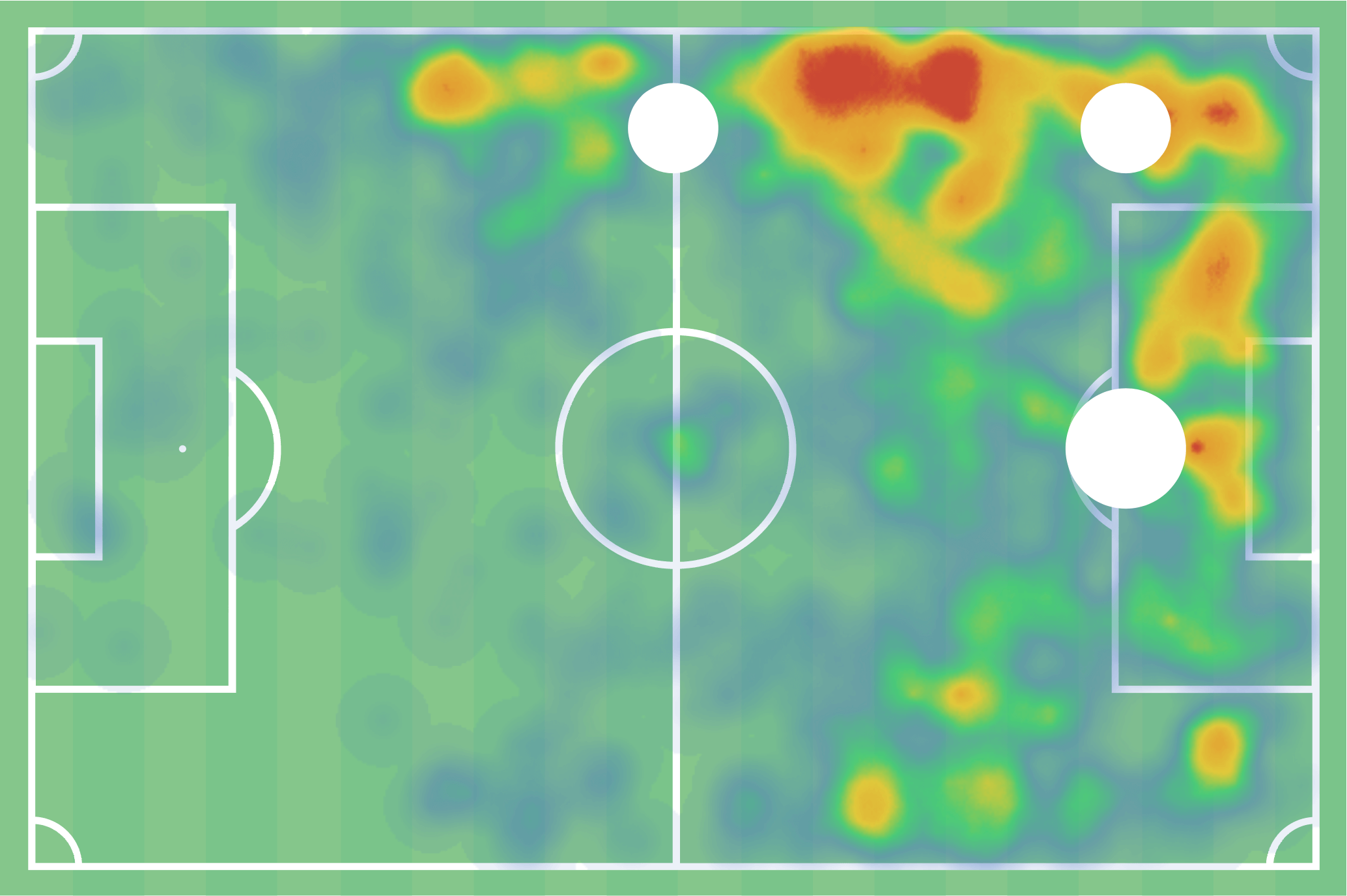
Nicolás González is a very versatile offensive player that can fulfil multiple roles, he has the speed and trickery in 1vs1 of a winger, the vision to find space of an attacking midfielder and the ability to get into good finishing positions, as well as to convert them, of a striker. This combination of characteristics not only allows González to play in different positions but also become a very unpredictable and creative player who can move around the pitch and feel comfortable operating in various areas. The Argentine usually looks for space to receive the ball in the final third. With his vast skill set, he becomes a real headache for defenders because they don’t know what his next action is going to be. This roaming around the final third is clearly visible in the heat map shown above, González played as a part of an attacking duo and that had him drifting wide or dropping deep to receive the ball quite often.
In order to have a better understanding of González’s abilities and style of play, we took a look at the data. Calculating percentile ranks for some key stats allowed for a comparison with other centre-forwards, wingers and attacking midfielders from his league. Taking the comparison a step further, we also calculated his percentile ranks on the same metrics but in comparison to all centre-forwards, wingers and attacking midfielders in the Bundesliga. While this is not a completely realistic comparison, due to the difference in quality and style between 2. Bundesliga and the Bundesliga, it allows us to have a picture of what could potentially be González’s ranks if he played in the Bundesliga this season. The comparison should always be seen having that difference between the leagues in mind, however, it gives us a glance of how González’s statistical profile fits in his new league.
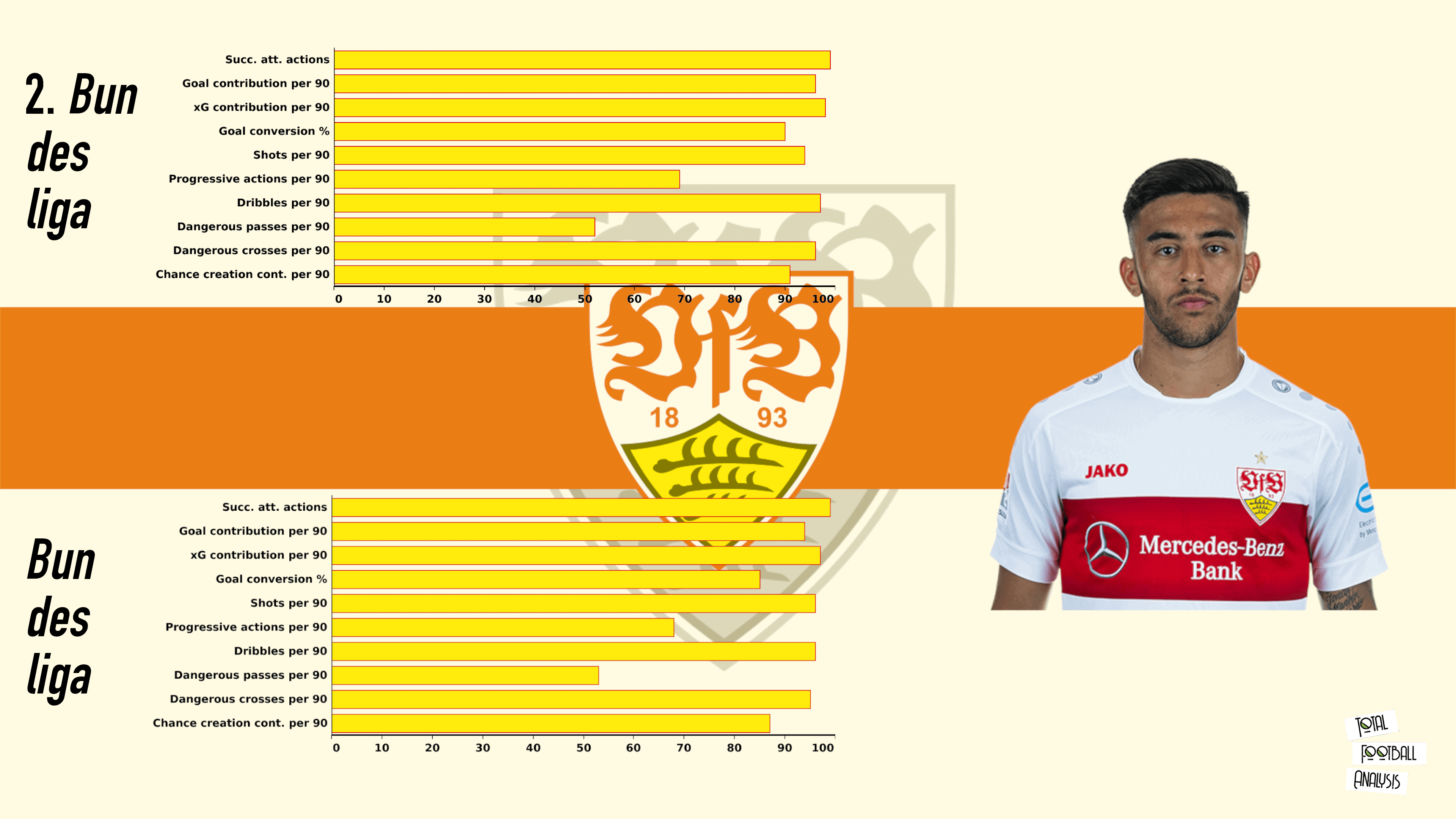
An analysis of the bar chart shows us how González had a very good season with VfB Stuttgart terms of his offensive output. The Argentine scores high in most metrics, he has impressive numbers in terms of goal contribution, goal conversion and dribbles per 90 while also contributing a lot to the creation of chances with a high number of dangerous crosses. The metric “dangerous passes per 90” was created adding passes to the final third per 90, deep completions per 90, and passes to the penalty area per 90 and the metric “Dangerous crosses per 90” was created by adding crosses to the goalie box per 90 and deep completed crosses per 90. In a similar fashion, the metric “chance creation contribution was created by adding third assists per 90, second assists per 90, assists per 90 and key passes per 90. González ranks high in two of these metrics proving his ability to link-up play, find teammates in dangerous positions and create chances for them to score, mostly through crosses.
When compared to Bundesliga players, González displays a very similar profile to the one he has when compared to players from his league and that is quite impressing. However, we should never forget that this comparison should always be seen and interpreted having in mind the difference between the level and style of play in the two leagues.
Having established González’s profile and his role as a mobile forward/winger, we will now take a look at his actions in the various phases of the game in order to complete this scout report. A tactical analysis of his gameplay will allow us to identify strengths and weaknesses, as well as have a better notion of his style of play.
Attacking Contribution
Finding Space
When his team is attacking, González usually searches for space top receive the ball in different areas depending on the position he is playing in. Operating as a winger, he is asked to provide full width in order to stretch the opposition’s back line and create space for runners in behind, as a result, González usually receives the ball next to the touchline in these occasions. Before getting to the final third, González usually looks to either combine with teammates in order to progress the ball up the pitch, take on is direct opponent if he is in a 1vs1 situation, or attack depth in behind the defensive line himself.
In the image below we can see Nicolás González taking part in Stuttgart’s build-up play. He receives the ball deep and wide and quickly combines with his teammate using a simple give and go. This simple combination allows Stuttgart to progress up the pitch and into the final third while also bypassing Nurnberg’s second line of pressure.
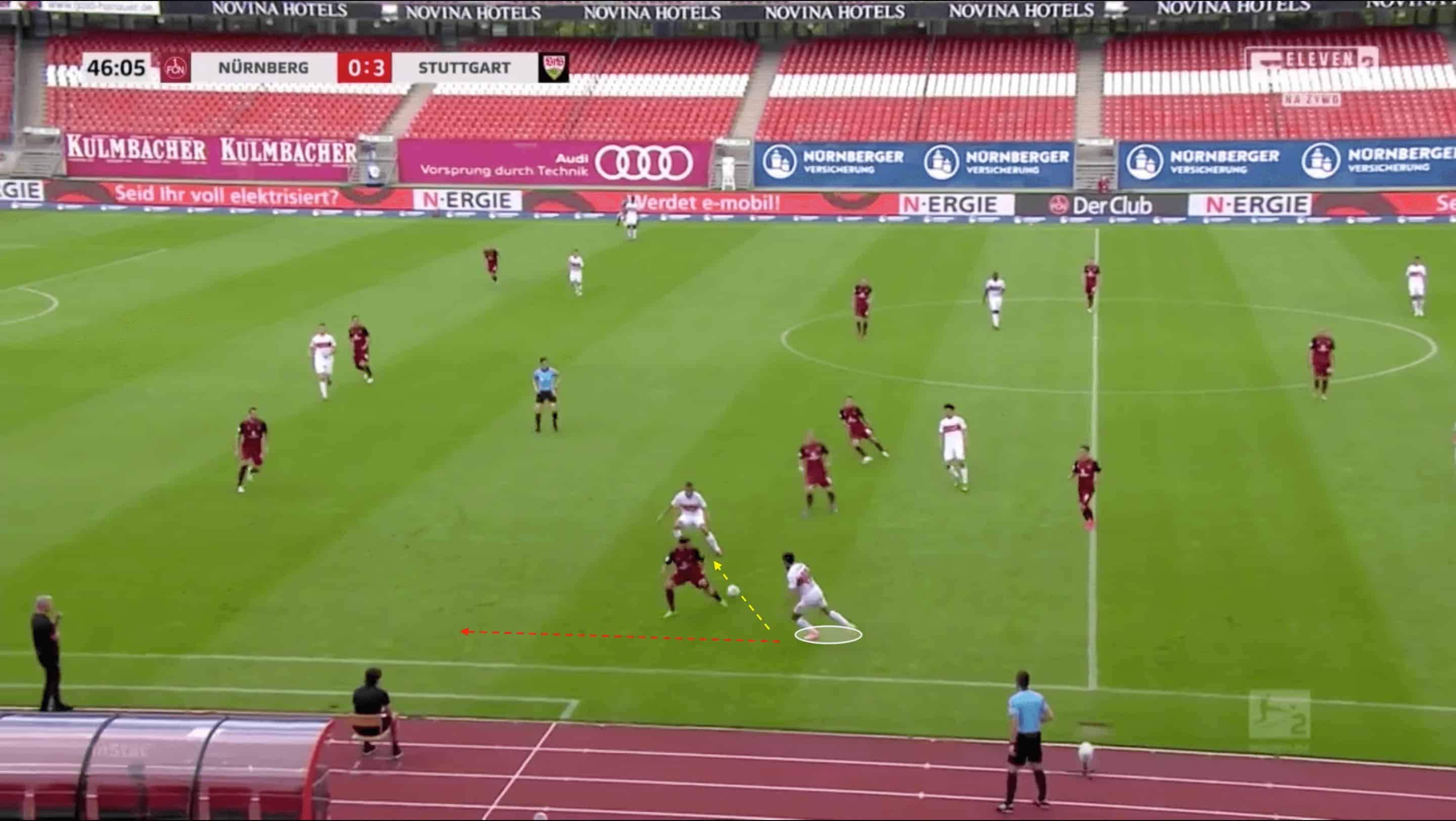
When playing as a centre-forward/second striker, González’s behaviour to find space is different. For starters, his starting position is higher up the pitch and either in more central areas or near the half spaces. From this positions González usually tries to find space to receive them in one of two ways: he drops in between the lines and searches for a pocket of space to receive the ball and turn or, he makes a run in behind the defensive line.
An example of the first situation can be found in the sequence of images below. González drops in between the lines to receive the ball in the half-space area, he scans his back to see where his opponent is and recognises he has just about time and space to receive the ball on the half-turn and face the opposition’s defensive line. He receives the ball on the half-turn perfectly and then quickly accelerates into space to create danger for the opposition.
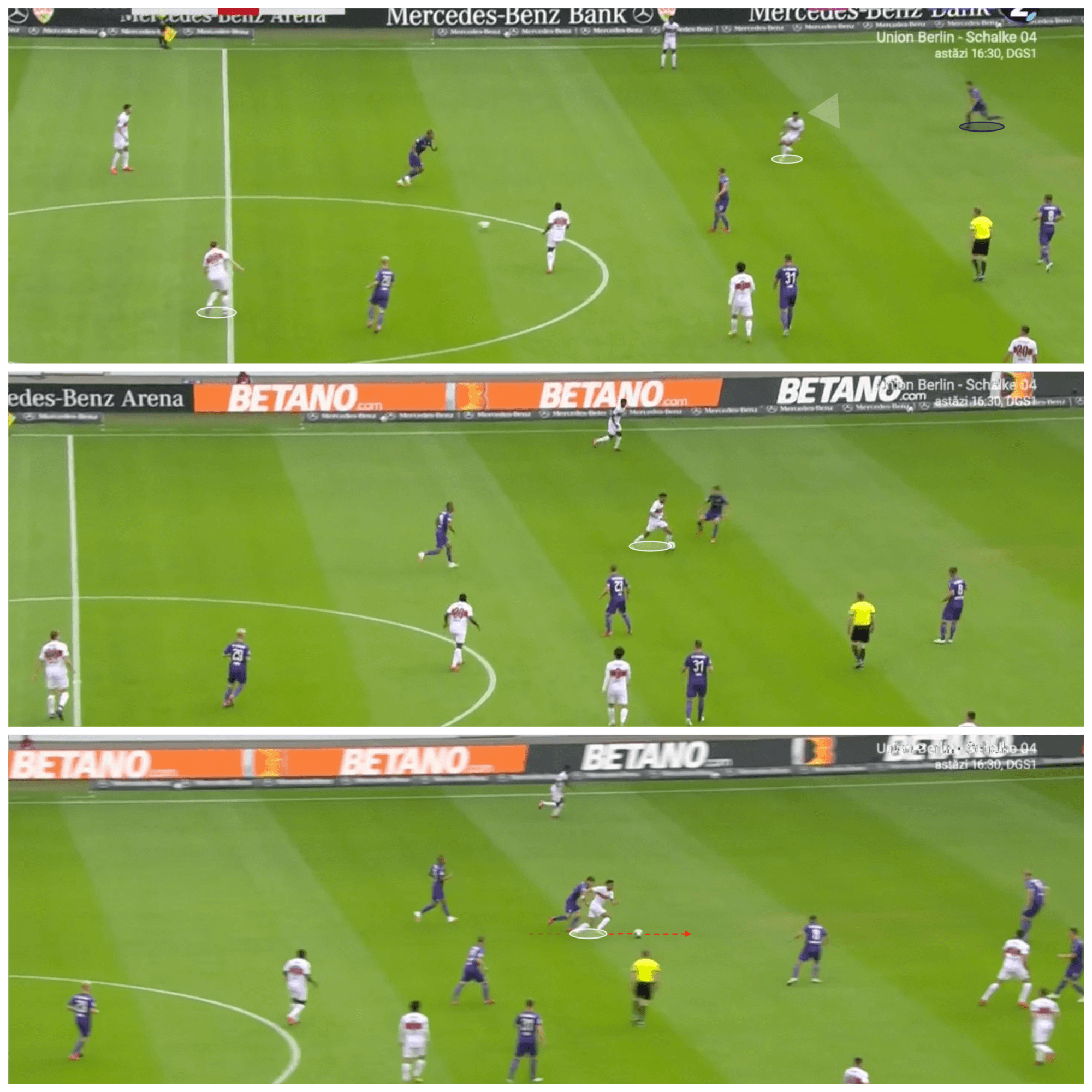
As it was already mentioned, González is a fast player able to create real difficulties to defenders with his pace. Besides accelerating with the ball on his feet, González is also seen making runs in behind the opposition’s defensive line in certain situations. These runs usually happen when González is already in the final third and the Argentine makes them in the wide areas or in the half space depending on the position he is playing in.
In the image below we can see González making a run in behind the opposition’s defensive line through the half-space. This situation usually occurs when González is playing as a centre forward/second striker.
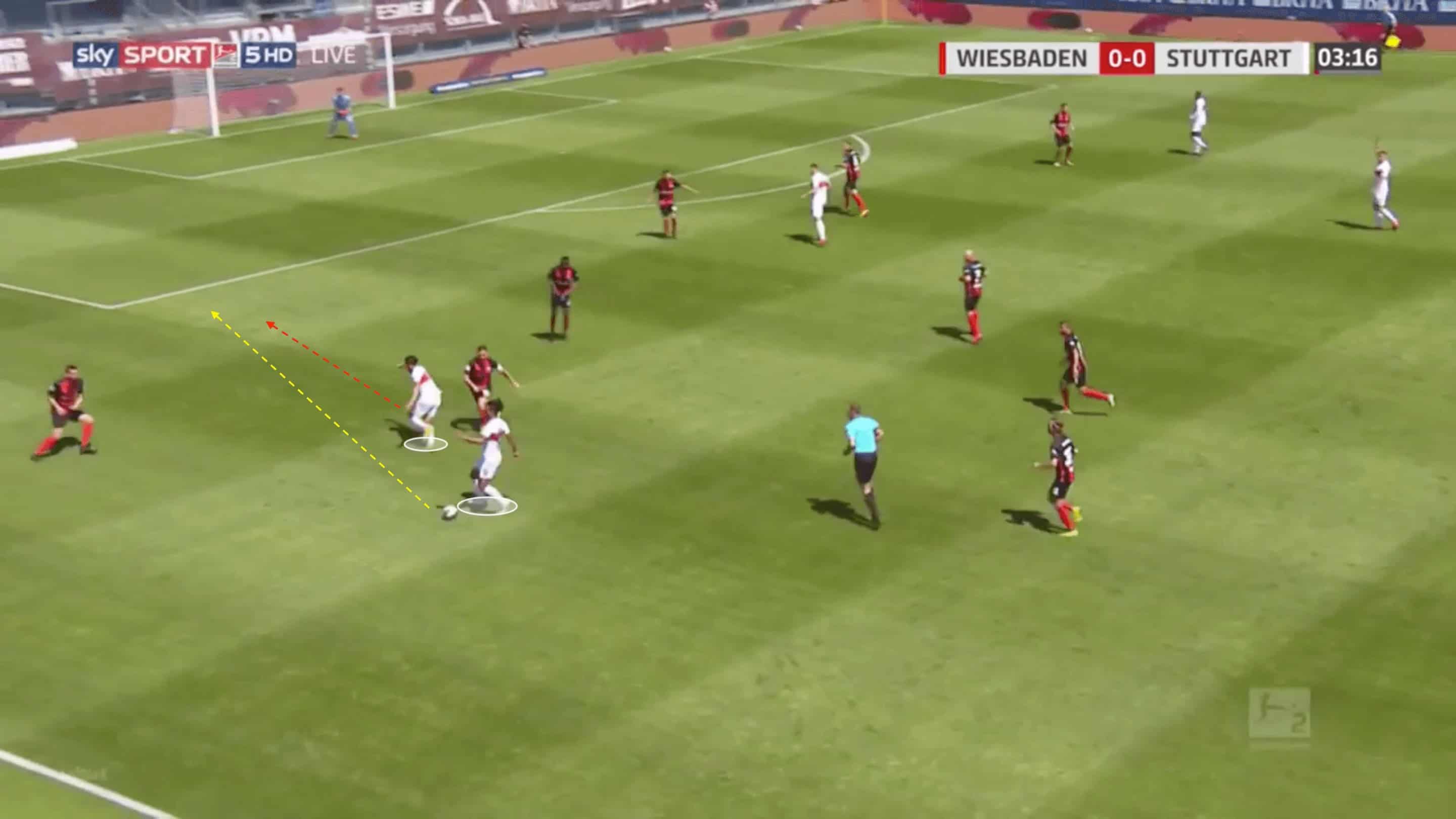
Creating chances
Despite his raw output being very superior in terms of goalscoring (14) when compared to his assist number (3), Nicolás González is a player very capable of creating chances for his teammates as well. He is a creative player, there is no doubt about that, not only with is passing or crossing but a lot with his dribbling and 1vs1 capabilities. González has very good ball control and is able to manoeuvre in high spaces efficiently. He also knows how to take on his opponents in 1vs1 situations very well and that translates into breaking lines, creating danger, gaining advantage and space to pass, shoot or cross, for example. González averaged 7.87 dribbles per 90 in the 2. Bundesliga with a 49.13% success rate, making him the 5th player with the most dribbles attempted per 90 and, in all likeliness, this big volume of dribbles certainly affecting the success.
After creating space, advantage, or breaking a line with his dribbling, or positioning, González is able to deliver the ball to his teammates in dangerous areas in various ways. If he receives the ball to his feet or finds himself further away from the opposition’s defensive line, González looks for space in behind the opposition’s defensive line and for teammates that can attack it. If there is space and players are ready to make runs, González delivers whipped crosses in behind the defensive line for runners to pick up and get in a 1vs1 against the keeper.
The image below shows an example of González playing a cross in behind the defensive line with two attackers making runs to get to the end of it.
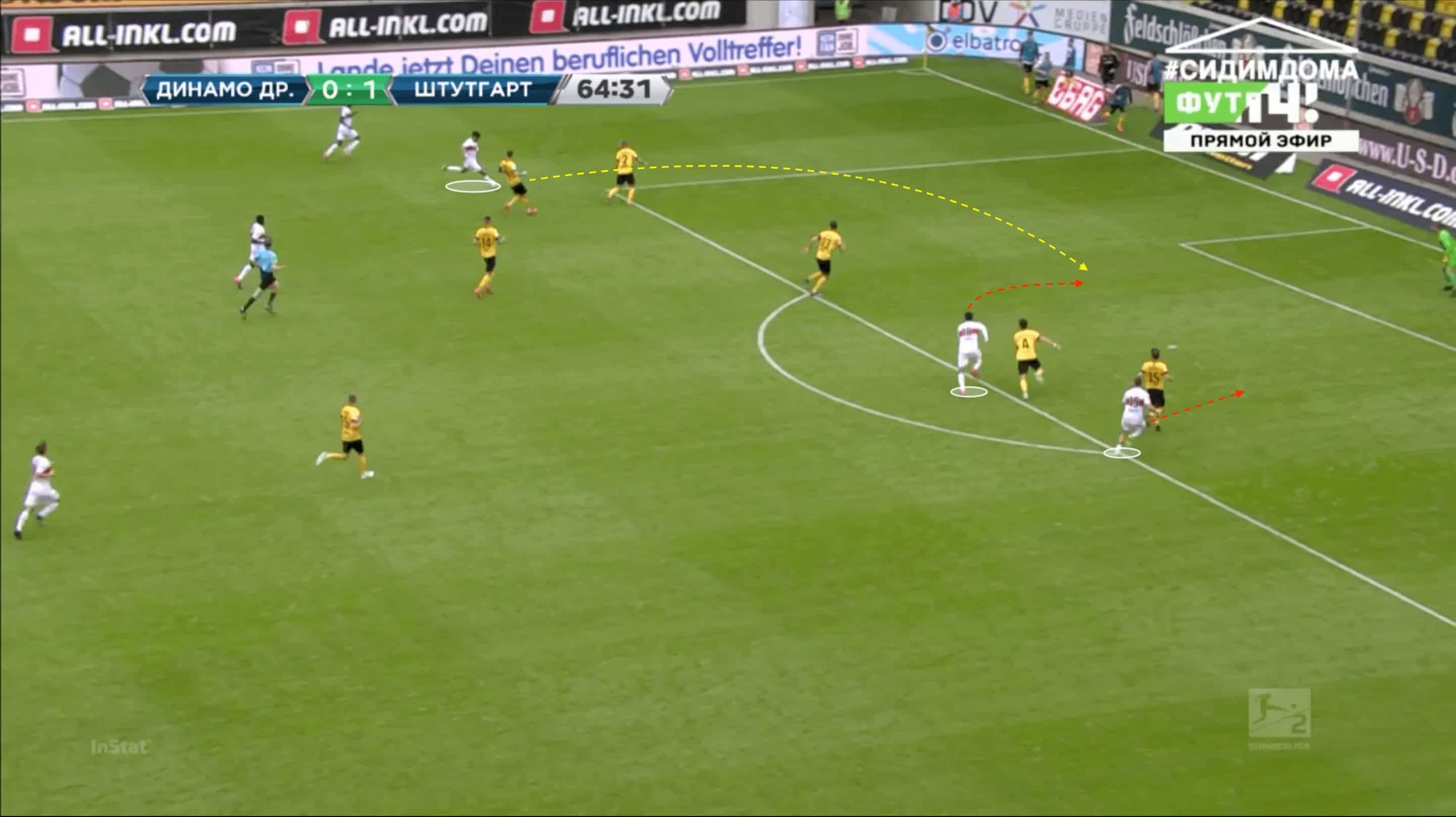
González delivers accurate curled crosses with very good power on them, the Argentine averaged 3.32 crosses per 90 with a 43.84% success rate, which are very good numbers in the league, apart from the mentioned situations where González plays crosses in behind the defensive line, if he receives the ball into space, he will go to the byline and play a pass across or cut the ball back. He also ranked very high in terms of dangerous crosses in the bar charts already shown, proving he creates chances with this side of his game.
When in the final third, González is also able to create danger with through passes for his teammates, the Argentine has very good vision, is able to spot runners, and has the passing technique to play accurate passes in behind the defensive line. This type of passes usually occurs when González is playing as a centre-forward/second striker and drops in between the line sot receive the ball. In that position he is often able to turn and face the opposition’s defensive line, giving him a full view of the runners and, therefore, passing lanes in behind the line.
In the image below we can see an example of the situation mentioned above. González dropped in between the lines to receive the ball, turned, and then spotted the free man making the run in behind.

For a better view of Nicolás González’s penalty area deliveries let’s take a look at the map below.
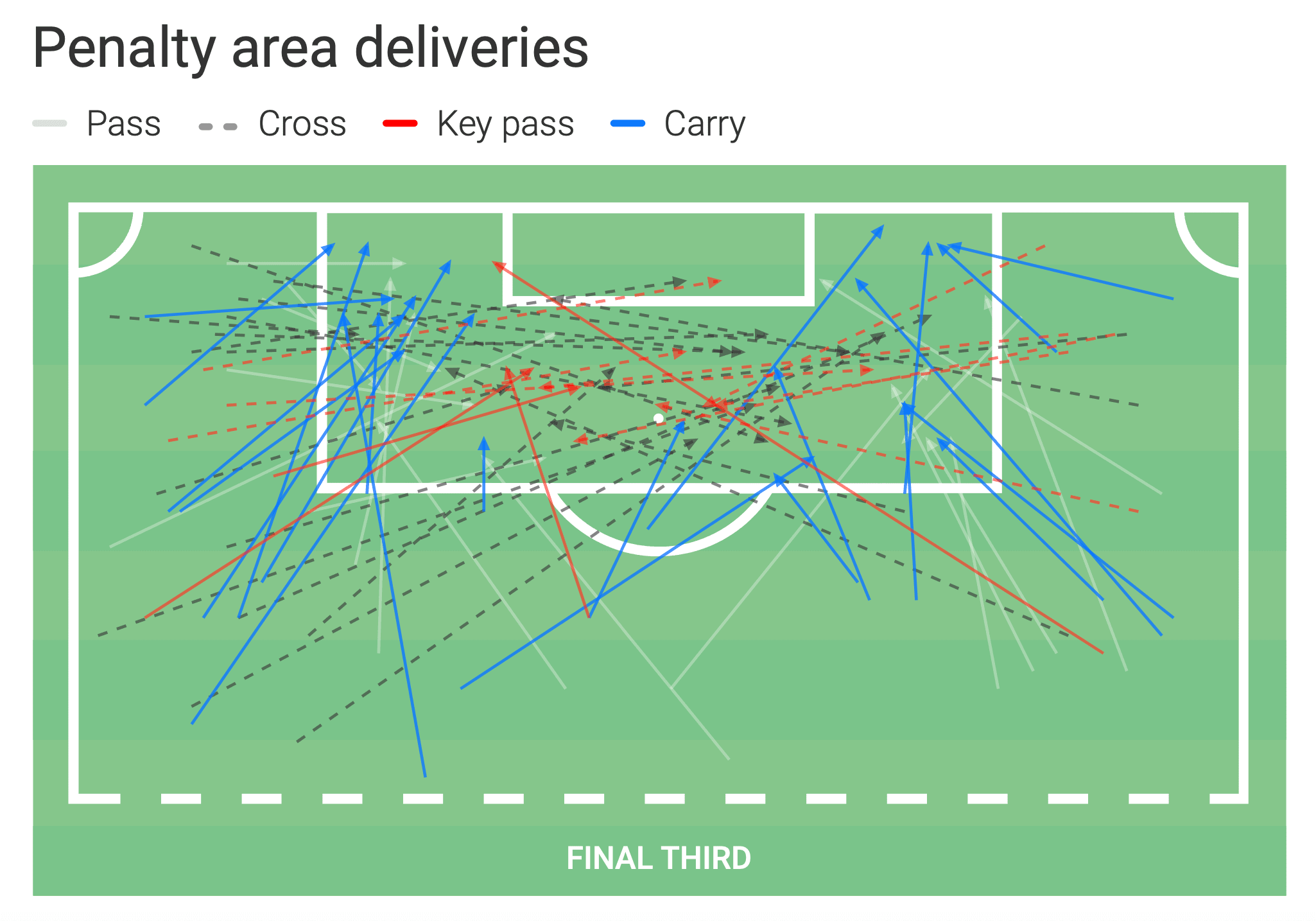
An analysis of the map shows us how most of the passes and some key passes come from the half and central spaces, and most of the crosses come from the already mentioned common areas and actions in González’s crossing: deeper crosses in behind the defensive line with teammates making runs to attack the space when he receives the ball to his feet or when he receives the ball into space after making a run himself, crosses from more advanced areas both in the wide and half spaces. The dribbling side of González’s game is also present in this map, the number of carries into the penalty area, as well as their starting points in the area, are consistent with where he receives the ball. He receives the ball in the wide channel when playing as a winger both deeper and further up the pitch and, in the half-spaces when he is playing as centre-forward and drops to receive the ball an turn.
Goalscoring
Goalscoring was a big part of González’s success in the 2019/2020 season for Stuttgart. The Argentine was the team’s top scorer in the league with 14 goals and a lot of that has to do with his ability to attack space and get into finishing positions regularly. González is, as we saw, a very mobile and fast player and, both playing as a winger and as a striker, he makes runs in behind the opposition’s defensive line if he feels the opportunity is there. The two things combined means that he is able to get in behind the defensive line when the time is right, he sometimes makes runs in behind while waiting right on the shoulder of the defender and other times he combines with his teammates and gets in behind with a “one-two” or a third man run.
In the image below we can see Nicolás González making a run in behind the defensive line on the half space. He is sitting right on the shoulder of the defender and then is able to take advantage of his speed and acceleration to get to the end of the pass.
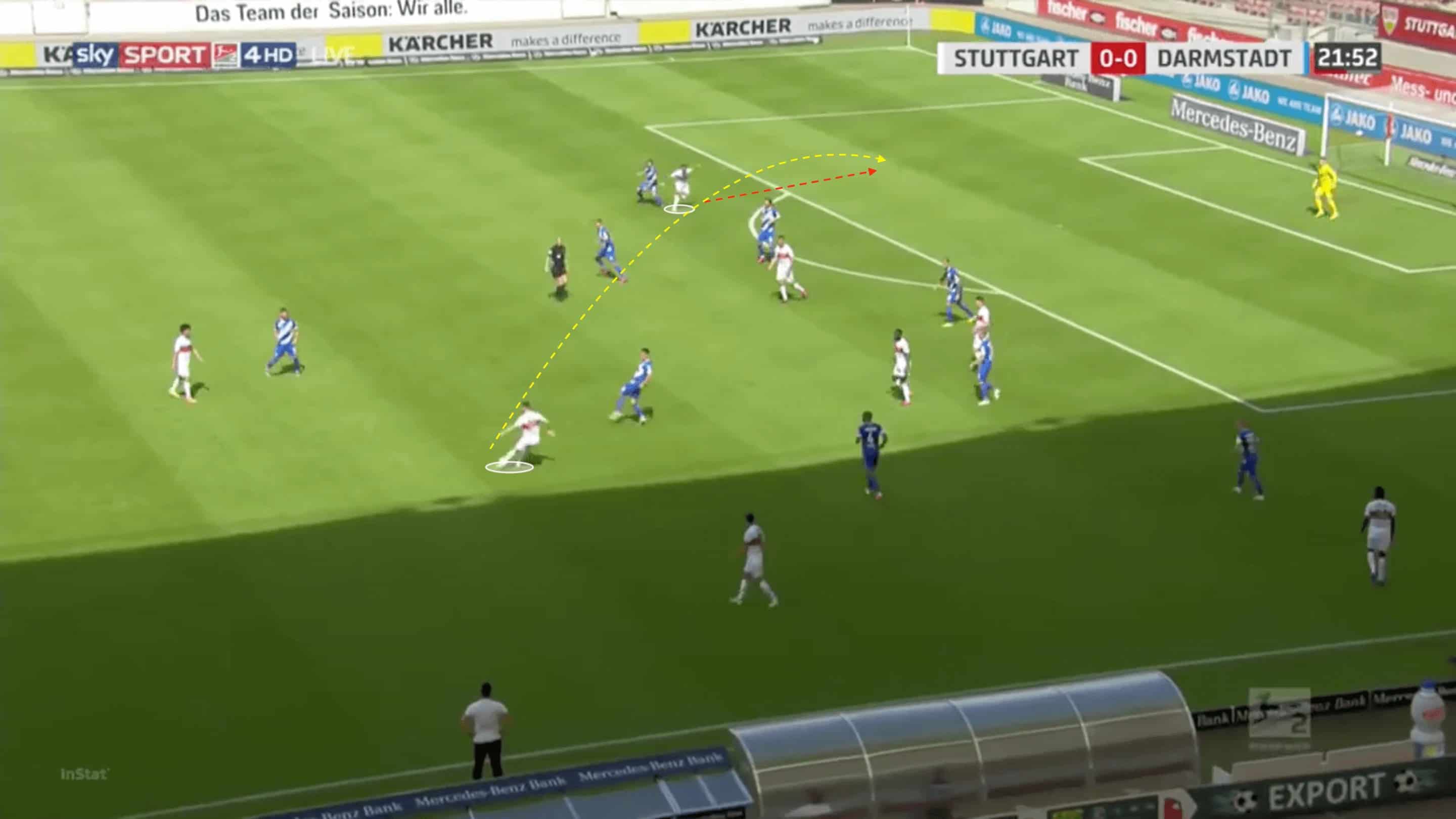
After getting into finishing position, González shows good finishing and shooting abilities and is able to provide good finishes with some consistency. The Argentine definitely needs to work on his weaker foot to be able to become a bigger shooting threat from more positions and angles, nevertheless, he is usually able to find space and angles to shoot with his left foot, by using the outside of his foot for example.
Nicolás González averaged 5.64 touches in the penalty area in the league which ranks him 5th in this metrics with an xG value per 90 of 0.61 which he surpasses with 0.64 goals per 90. This shows he not only is getting into good positions to score but also actually converting some of the chances he has. He averages 3.18 shots per 90 with 50% of them being on target and has a goal conversion of 20%
Conclusion
In this scout report, we took a look at Nicolás González’s statistical profile and compared it with other players form both 2. Bundesliga and the Bundesliga, the young man form Argentine showed very impressive scores in almost every key metrics although it should be noted that the comparison made with Bundesliga players should always be seen taking the difference between the leagues into account.
Does that same comparison also raise one question? Is Nicolás González ready to play Bundesliga football and compete with the likes of Bayern Munich and Borussia Dortmund that play in the Bundesliga every season?
An analysis of González’s in-game actions gave us a view of his strengths and weaknesses while also making evident some traits and components of his style of play. The analysis of his behaviour in different positions and roles when adapting to tactics made evident how versatile González is and how he is a promising forward. The verdict?
González is going to be competing in the Bundesliga next season and that is definitely a big step up in terms of quality and level, nevertheless, González looks like he is ready to compete in the German top tier, the number suggests so, and, so far, the performances have been confirming it.






Comments